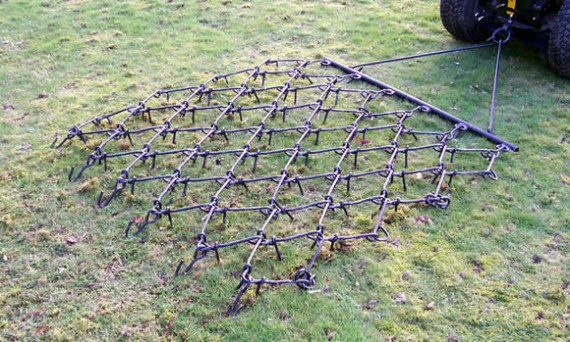Mechanical operations
The three most important mechanical operations for maintaining and improving grassland are:
- harrowing
- rolling
- topping
You may probably need to spread lime or PK fertiliser every two to five years, but you should be able to get a contractor to do this. Or small spreaders are available to tow behind an ATV or small tractor.
Harrowing
Grass harrows come in two types – chain and tine. The purpose of harrowing is to drag out the thatch of dead grass and moss and to promote new growth by allowing air, moisture and light to reach the new shoots, so is carried out in the spring.
 A chain harrow
A chain harrow
Harrowing is also used to break up and disperse dung piles, especially when cattle and horses have been grazing. Chain harrows have been traditionally used; tine harrows are more recent but are much more expensive to buy.
Harrowing doesn't need to be a mechanical process - our highland pony Smokey pulls a chain harrow, and you can learn more on our working pony course.
Rolling
Grass is usually rolled after harrowing. This has two purposes; first to push any stones into the soil so that they don’t foul any machinery, particularly toppers or mowers and secondly to ensure that plant roots are in contact with the soil.
The timing of rolling is important – the soil has to be dry enough to take the vehicle without damage but soft enough for the stones to be pushed into it.
Topping
Topping is cutting the sward at a height of about 7.5cm (3”) before weeds and grass have a chance to seed, in much the same way as hard grazing would do. The cut height can decrease through the season to 2.5cm (1”). Ideally, it should be done monthly from June to October, but it must be done at least once a year. Topping weakens weeds but makes the grass grow better.
A topper is similar to, but not the same as, a mower and will not cope with cutting a full hay crop. As the cuttings are left on the field, it is vital to remove any ragwort before topping as cutting and wilting renders it more palatable to stock but no less poisonous.

About Rosemary Champion
Rosemary lives on a 12 acre smallholding in Angus, in the east of Scotland, where she keeps Ryeland Sheep, Shetland cattle and assorted poultry. She was destined to be a smallholder from an early age.
Further Reading
 Weed Management for Organic Farmers, Growers and Smallholders Gareth Davies |  Improved Grassland Management John Frame |











